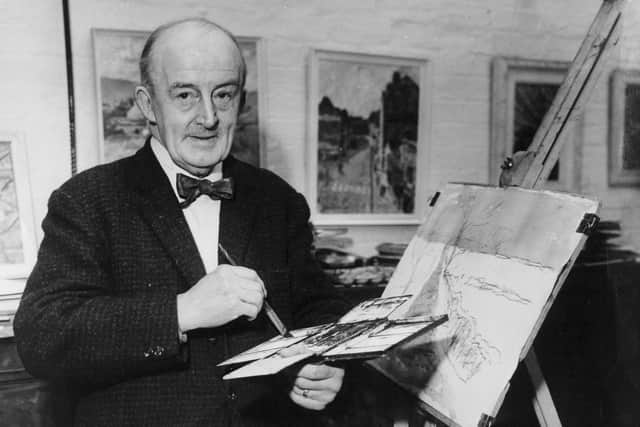Bradford-born author who nearly died writing his grandfather Percy Monkman's biography releases new book on city's history
On this day 12 years ago Keighley-born Simon Beaufoy won the best adapted screenplay Oscar for the hit British film Slumdog Millionaire.
As Yorkshire-born Martin Greenwood notes in his new book, Every Day Bradford, when award presenter Tina Fey quoted Charlotte Brontë as she prepared to unveil the winner - “the writer who possesses the creative gift owns something of which he is not always master” - she was unlikely to know that the two talents had in different periods lived in what is now the same city.
Advertisement
Hide AdAdvertisement
Hide AdBut if anything, Greenwood’s anthology of Bradfordian heritage neatly illustrates the city’s claim of creating a great number of people who changed the course of society (as famous son of Heaton, author JB Priestley, also argues on the back cover).


The book uses each day of the calendar year to tell a story from the city’s history that occurred on that particular date.
There are tales related to the city’s most obvious famous names: the Brontë sisters, Sir Titus Salt, David Hockney.
But less documented and unusual anecdotes are also given space alongside a “warts and all” catalogue of the city’s darker days.
Advertisement
Hide AdAdvertisement
Hide AdThe late Bradfordian entertainer, actor and painter Percy Monkman is also mentioned on a few pages - the author’s grandfather would have been an odd omission.


It was actually Greenwood’s penning of the 2018 biography Percy Monkman: An Extraordinary Bradfordian that led him to chart the city’s history in his latest effort.
As he puts it in the new book’s preface: “It is now over fifty years since I left Bradford, but it still has a strong hold. Both sides of my family were Bradford born and bred, going back over three generations, as they came to the city looking for work like so many others before and since.
“When I came to write a biography in 2017 about my grandfather, Perry Monkman, who lived all his life in and around the city except for four WW1 years in Northern France, I found myself digging back into the past to find out more about the city he loved and the Bradford lives of his parents and grandparents. I learnt just how little I really knew about the place where I myself had been brought up for 20 years.”
Advertisement
Hide AdAdvertisement
Hide AdIt’s something of a surprise Greenwood, 74, did continue to write after his last book - because it put him in a coma.


During the research period he was placed in intensive care for 11 days after experiencing severe breathing difficulties and, for the first time in his life, an asthma attack.
His grandfather, who died in 1986, had kept an extensive record of documents and press clippings about his achievements.
Greenwood had sifted through them in his attic for many weeks to aid his project and unknown to him, inhaled spores which had remained dormant inside the papers for up to 100 years.
Advertisement
Hide AdAdvertisement
Hide AdIn January 2017, he was taken to hospital and woke up six days later following an induced coma.
His struggles made headlines in The Times and The Daily Mirror as it was “quite a story but pretty serious at the time,” he says.
After recuperating he finished the biography, and from November 2018 with the help of his brother Adrian - who e-mailed ideas and suggestions from his residence in Germany -
Greenwood developed the next idea by combing through press archives and making trips to Bradford every few weeks from his home in Warwick. His wife, Jenny, also fed him stories she had spotted on social media and was happy for him to take journeys to West Yorkshire.
Advertisement
Hide AdAdvertisement
Hide AdThe idea of charting the city through each day of the year initially came after he read television historian Dan Snow’s On This Day in History, which he’d seen him deliver a talk on.
Retired IT consultant Greenwood says: “To begin with I thought it was a rather gimmicky idea, I couldn’t see how it would work, because you’d be jumping from stories about Confucius to the French Revolution to World War Two or whatever.
“But when I read the book - well he gave a great talk, he was really passionate about what he’d done - I actually thought it worked in that he’d captured the sheer diversity of what happened in the world in a way that you wouldn’t ever get if you sat down to a conventional book on world history. It would be rather difficult wouldn’t it?
“Suddenly I got this idea: why not think of Bradford as the world? Why not do a book about Bradford taking any theme, any topic, any event, person, place with a story linked to it and do the same?”
Advertisement
Hide AdAdvertisement
Hide AdOne of his favourite tales from the book is of Ann Daniels, the Bradford woman who on January 23 2000 reached the South Pole as member of the first all-women team to do so.
Previously, after growing up in an Allerton terrace house during what Greenwood describes as an “ordinary life”, she tried fertility treatment unsuccessfully for several years before attempting IVF - and had triplets.
Greenwood, who grew up near Valley Parade in Manningham and belonged to Keeling House at Bradford Grammar School, was also interested in the city’s 19th century history and the disparity in wealth between mill owners and the struggles of the people who worked in them. He also felt that some of the city’s more sinister history must be included.
“Most of the books about Bradford tend to miss out all sorts of important events,” he says.
Advertisement
Hide AdAdvertisement
Hide Ad“When you live through the Yorkshire Ripper in the late 70s and the early 80s, it was a massive part of our life and I just didn’t want to ignore that, in fact, three or four of the most infamous serial killers came from Bradford. Not to mention these public executioners. So I wanted it to be warts and all, I didn’t want it to be a sanitised, bland thing.”
The entry for February 23 tells how in 1956 hangman Albert Pierrepoint, who was from Clayton, resigned as the last state executioner over a pay dispute. Four such executioners, including Pierrepoint, his father Henry and uncle Thomas, as well as James Berry, had Bradford connections.
Observers will also note the book’s front cover contains a subtle tribute to Bradford itself. It incorporates images from Ivegate Arch, the steel gateway designed by Peter Parkinson and made by Richard Quinnell which in 1988 was put up at the entrance to one of the city’s oldest streets, where it remains.
“When I was there, I was not that interested in the physical surroundings,” says Greenwood.
Advertisement
Hide AdAdvertisement
Hide Ad“My granddad used to talk about it, complain about pulling down all these wonderful old buildings but that went over my head really, I have to say. But now I feel really cross about it. And I also see the city much more positively when I go there.”
Every Day Bradford is available from book sellers now.
Inspired by his grandfather
Percy Monkman (1892 – 1986) was a watercolour artist who mainly painted Yorkshire Dales and Pennine landscapes as well as urban scenes around Bradford.
A banker by trade, he was born and lived in Bradford and after he retired in 1952, aged 60, he moved to Baildon on the edge of the moors, where he lived for another 34 years.
Joining the army in 1915 as a stretcher bearer in the Royal Army Medical Corps, he soon volunteered with an entertainment troupe as a comedian and spent the rest of the First World War lifting the spirits of soldiers behind the front at the Somme.
He later had an acting career, appearing at the Bradford Civic Playhouse in 27 productions, including in several plays written by his lifelong friend JB Priestley.